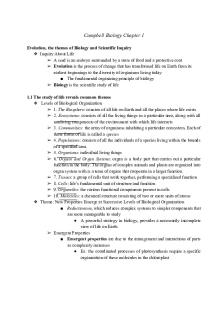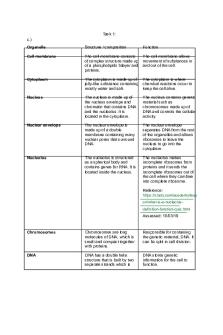Cell book notes ch 1 - Campbell Biology in Focus PDF

| Title | Cell book notes ch 1 - Campbell Biology in Focus |
|---|---|
| Author | Misheel Dolguun |
| Course | Intro to Cell & Molec Biology |
| Institution | Tulane University |
| Pages | 4 |
| File Size | 46.5 KB |
| File Type | |
| Total Downloads | 48 |
| Total Views | 147 |
Summary
Dr V - entire 1st chapter notes...
Description
1.1 ● ● ●
●
●
● ● ●
● ● ● ● ● ● ●
● ●
● ●
Eukaryotic cell contains membrane-enclosed organelles Prokaryotic cell lacks a nucleus or other membrane-enclosed organelles ○ Also generally smaller than eukaryotic cells Within cells, structures called chromosomes contain genetic material in the form of DNA (deoxyribonucleic acid) ○ Each chromosome has 1 very long DNA molecule w hundreds/thousands of genes - each a section of the DNA of the chromosome Genes = the units of inheritance, transmitted from parents to offspring ○ They encode info necessary to build all of molecules synthesized in cell - which establish cell’s identity & function Molecules structure of DNA accounts for its ability to store info ○ DNA molecule is made up of 2 strands arranged in a double helix ○ Each chain is made up of nucleotides - A,T,C, & G ■ Specific sequences of the 4 nucleotides encode info in genes ● Sequence provides blueprint for making a protein Proteins = important in building & maintaining cell & carry out its functions Protein-encoding genes control protein production indirectly, using mRNA as intermediary Sequence of nucleotides along gene is transcribed into mRNA, then translated into amino acids (chain of protein building blocks) ○ Once complete, amino acid chain form a specific protein w unique shape & function Gene expression = entire process by which info in a gene directs production of a cellular product Genome = all genetic instructions an organism inherits Genome sequence = entire sequence of nucleotides for a representative member of a species Genomics = study of whole sets of genes in one or more species Proteomics = study of proteins & their prop.s Proteome = entire set of proteins expressed by a given cell, tissue, or organism Plant’s leaves absorb sunlight through photosynthesis & molecules in leaves convert energy of sunlight to chemical energy of food (like sugar), chemical energy in food molecules is passed from plants & producers to consumers Consumer = organism that obtains its energy by feeding on other organisms/their remains When an organism uses chemical energy for work some is lost to the surroundings as heat, then energy flows through ecosystem in one direction - usually entering as light & exiting as heat Chemicals cycle within an ecosystem - used & recycled Chemicals plant absorbs passed to animal that eats plant, chemicals returned to environment by decomposers (like bacteria & fungi) that break down waste, chemicals can now by taken by plants again - completes cycle
●
Extinction = permanent loss of a species
●
Evolution = process of biological change, species accumulate diff.s form ancestors as they adapt to different environments over time 3 higher levels of classification: Bacteria, Archaea, & Eukarya ○ Domain bacteria - bacteria = most diverse & widespread prokaryotes, multiple kingdoms ○ Domain archaea - multiple kingdoms ○ Domain eukarya ■ Kingdom plantae - multicellular eukaryotes that carry out photosynthesis ■ Kingdom fungi - absorb nutrients from outside their bodies ■ Kingdom animalia - multicellular eukaryotes that ingest other organisms ■ Protists - mostly unicellular eukaryotes & some relatively simple multicellular relatives ○ Bacteria & archaea consist of single celled, prokaryotic organisms ○ All eukaryotes are grouped in domain Eukarya ■ This domain include 3 kingdoms of multicellular eukaryotes: Plantae, Fungi, & Animalia ■ Kingdoms are distinguished by their modes of nutrition ● Plants produce their own sugars & other food molecules through photosynthesis ● Fungi absorb dissolved nutrients from surroundings ● Animals obtain food by eating & digesting other organisms ■ Protists = most numerous & diverse eukaryotes, single celled Darwin’s 1st point - “Descent w modification” = species accumulate differences form ancestors as they adapt to diff. Environments over time 2nd point - “Natural selection” = primary cause of descent w modification Darwin’s 3 essential observations: ○ 1. Indv.s in a pop. vary in their traits, many of which seem to be heritable ○ 2. A pop. can produce more offspring that can survive to produce offspring of their own ■ Comp. is inevitable ○ 3. Species generally suited to their environments ■ From 3 observations Darwin reason that indv.s w inherited traits that are better suited to the local environment are more likely to survive & reproduce than less-well suite indv.s ■ Over generations a more indv.s in a pop. will have advantageous traits ● Called this natural selection bc natural environment ``selects” for propagation of certain traits among naturally occurring variant traits in pop. Darwin proposed that natural selection by cumulative effects over long periods of time could cause an ancestral species to give rise to 2 or more descendant species
1.2
●
● ● ●
●
○
One species could gradually radiate into multiple species as the geographically isolated pop.s adapted over many generations to diff. Environmental conditions
1.3 ● ●
● ●
● ● ● ● ●
●
● ●
Inquiry = search for info & explanations of natural phenomena Data = recorded observations ○ Data = items of info on which scientific inquiry is based ○ Qualitative data = descriptions of what is observed ○ Quantitative data = numerical measurements which are organized Inductive reasoning = derive generalizations from large # of specific observations Hypothesis = an explanation, based on observations & assumptions that leads to a testable prediction ○ Explanation on trial ○ Ration accounting for a set of observations, based on available data - guided by inductive reasoning ○ Must lead to predictions that can be tested by experiments Experiment = scientific test carried out under controlled conditions Deductive reasoning = from general premises, extrapolate to specific results that should be expected if premises are true Hypothesis can never be proved beyond all doubt Hypothesis must be testable Ex. case - coat coloration in mouse pop.s ○ Beach mouse & inland mouse - hypothesis = coloration patterns evolved as adaptations that camouflage mice in their native environments, protecting them from predation - mice w coloration not matching habitat will be preyed on more heavily than native, well matched mice ○ Experiment - Spray painted mouse models w light or dark color patterns matching beach & inland mice & placed models in both habitats then counted damaged or missing models ○ Results - models whose pattern didn’t match surroundings suffered much higher predation than camouflaged models ○ Conclusion - results consistent w researchers prediction that mouse models w camouflage coloration would be attacked less often than non-camouflaged mouse models ■ Experiment supports camouflage hypothesis ○ Mouse models resembling native mice in habitat = control group & models w non-native coloration = experimental group Controlled experiment = compare experimental group w control group ○ Factor that is manipulated & factor subsequently measured = variables (feature/quantity that varies in an experiment) Independent variable = factor manipulated ○ Color of mouse model Dependent variable = factor being measured that is predicted to be affected by independent variable
○ Amount of predation in response to variation in color of mouse model Theory is much broader in scope than hypothesis ○ General enough to spin off new, testable hypotheses ○ Generally supported by a much greater body of evidence compared to any one hypothesis ○ Scientist will modify or reject a previously supported theory if new research consistently produces results that don’t fit ■ Truth is conditional based on weight of available evidence ● Goal of technology is to apply scientific knowledge for some specific purpose More notes ● Reductionism - reduce complex systems to simpler, more manageable components ● Systems biology - seeks to understand how all the parts work together ● Nutrients are always recycled ● Energy flows through ● how the info encoded in DNA is actually used by organisms - Dna is transcribed into RNA and then translated into proteins ● Control does not receive experimental treatment ●...
Similar Free PDFs

Campbell Biology Chapter 1
- 8 Pages

Cell Biology - Lecture notes 1
- 35 Pages

Unit 1 Cell Biology - notes
- 5 Pages

Cell biology lecture notes
- 108 Pages

Cell biology revision notes
- 5 Pages

Cell biology L2-12 notes
- 21 Pages

Cell biology summary notes website
- 33 Pages

Ch26 - Summary Campbell Biology
- 6 Pages

Biology Notes Ch 8
- 5 Pages

Cell biology
- 3 Pages
Popular Institutions
- Tinajero National High School - Annex
- Politeknik Caltex Riau
- Yokohama City University
- SGT University
- University of Al-Qadisiyah
- Divine Word College of Vigan
- Techniek College Rotterdam
- Universidade de Santiago
- Universiti Teknologi MARA Cawangan Johor Kampus Pasir Gudang
- Poltekkes Kemenkes Yogyakarta
- Baguio City National High School
- Colegio san marcos
- preparatoria uno
- Centro de Bachillerato Tecnológico Industrial y de Servicios No. 107
- Dalian Maritime University
- Quang Trung Secondary School
- Colegio Tecnológico en Informática
- Corporación Regional de Educación Superior
- Grupo CEDVA
- Dar Al Uloom University
- Centro de Estudios Preuniversitarios de la Universidad Nacional de Ingeniería
- 上智大学
- Aakash International School, Nuna Majara
- San Felipe Neri Catholic School
- Kang Chiao International School - New Taipei City
- Misamis Occidental National High School
- Institución Educativa Escuela Normal Juan Ladrilleros
- Kolehiyo ng Pantukan
- Batanes State College
- Instituto Continental
- Sekolah Menengah Kejuruan Kesehatan Kaltara (Tarakan)
- Colegio de La Inmaculada Concepcion - Cebu





